Urban-Induced Mechanisms for an Extreme Rainfall Event in Beijing China: A Satellite Perspective
Abstract
:1. Introduction
- Urban aerosol-cloud-rainfall mechanism: Beijing has a large amount of aerosols. These aerosols serve as cloud condensation nuclei to form clouds and rainfall (e.g., aerosol indirect effect) [23,24]. Aerosol optical thickness (AOT) and cloud fraction were extremely high before the 721 event, implying this mechanism;
- UHI-convection mechanism: Urban heat island effect (UHI) means the urban surface is hotter than surrounding regions. As a result, the UHI changes the temperature gradient at the surface, forms strong surface convection, and modifies local and regional circulations (so-called “urban canyon”);
- Urban canyon-lifting effect: Urban tall buildings force mechanical turbulence (and therefore convergence), enhance cloud formation, and consequently strengthen rainfall.
2. Data
2.1. TRMM Precipitation Data
2.2. MODIS Skin Temperature Data
2.3. MODIS Atmosphere Data:
3. Results
3.1. Urban Growth of Beijing
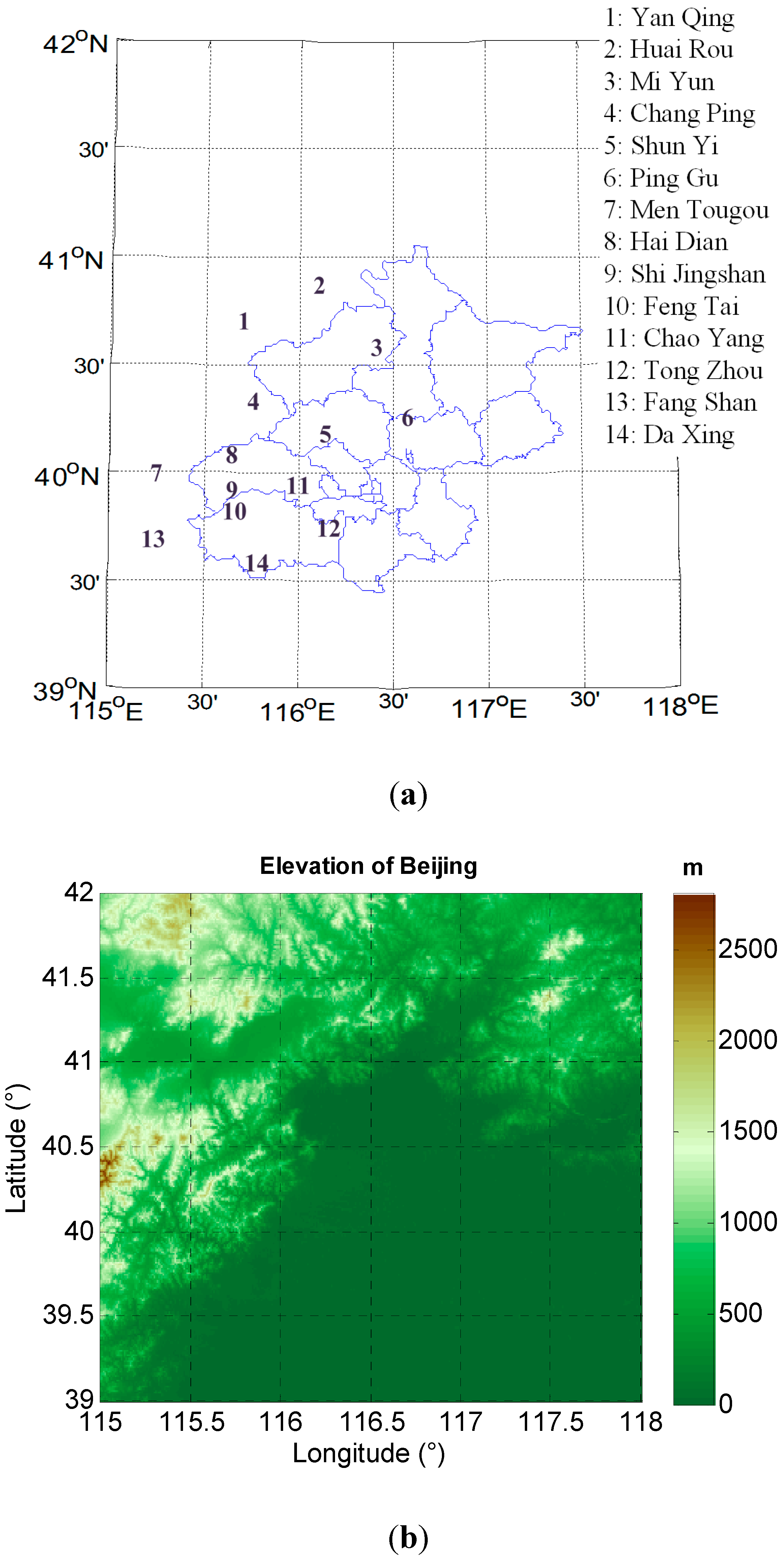
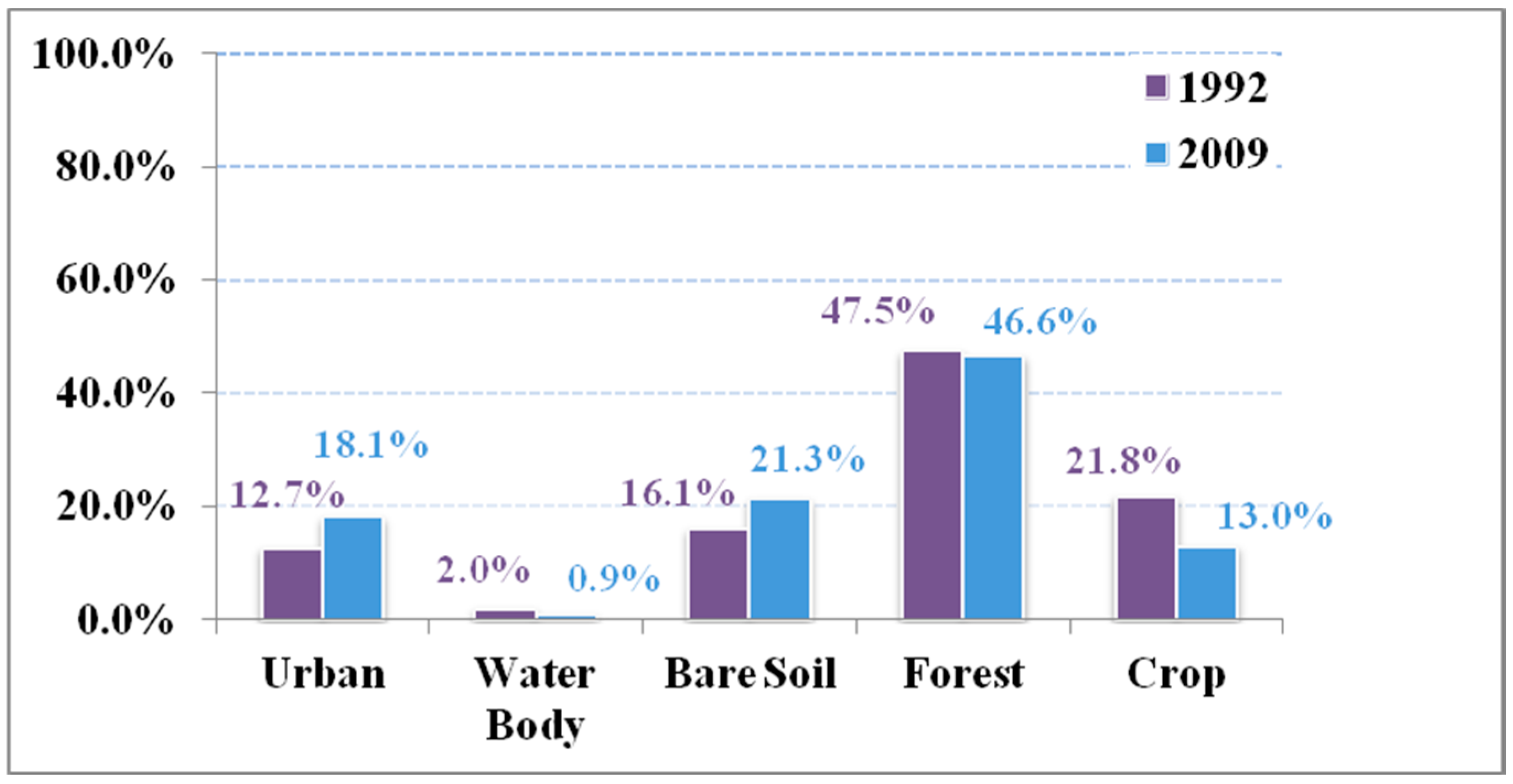
3.2. Rainfall Event
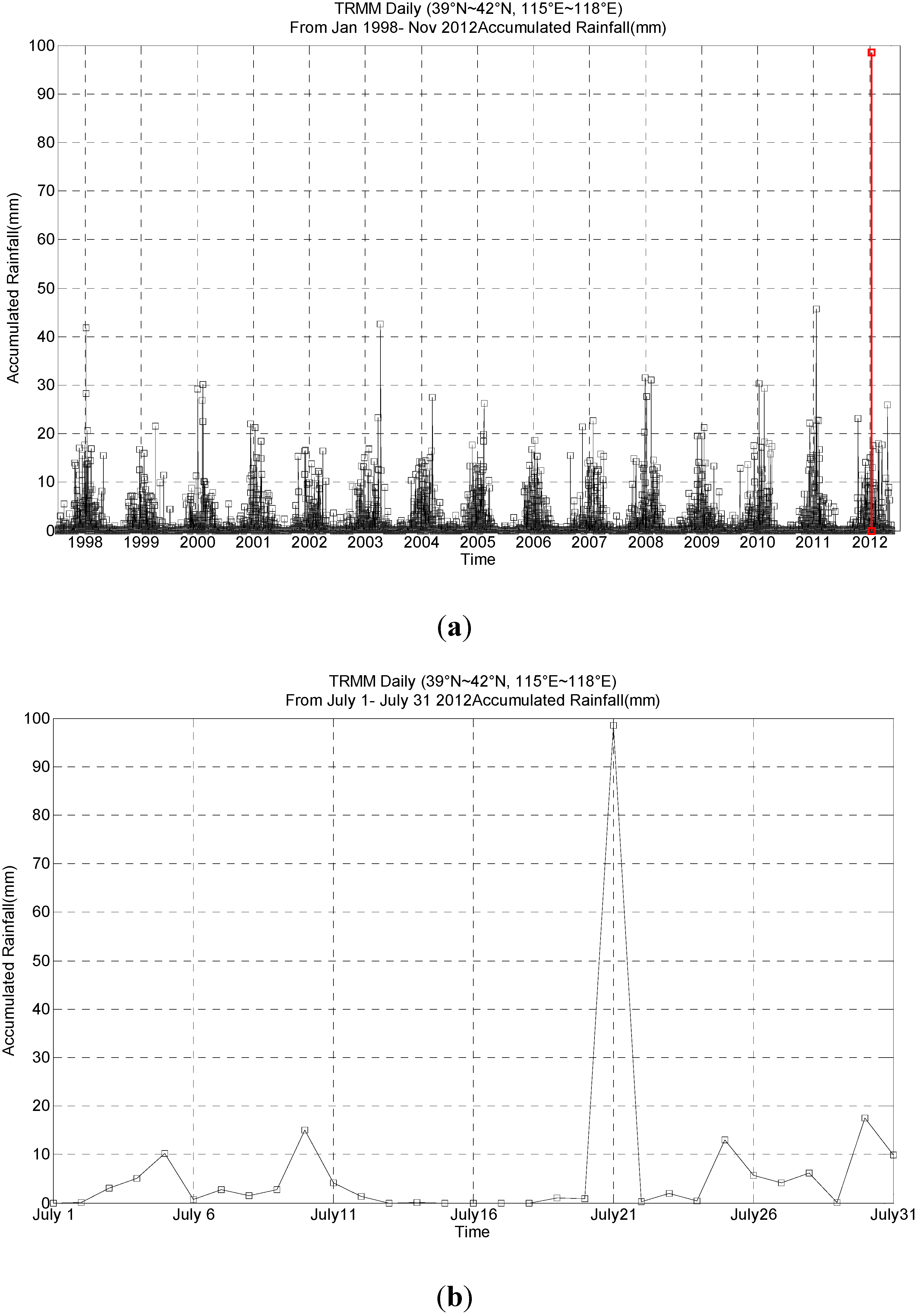
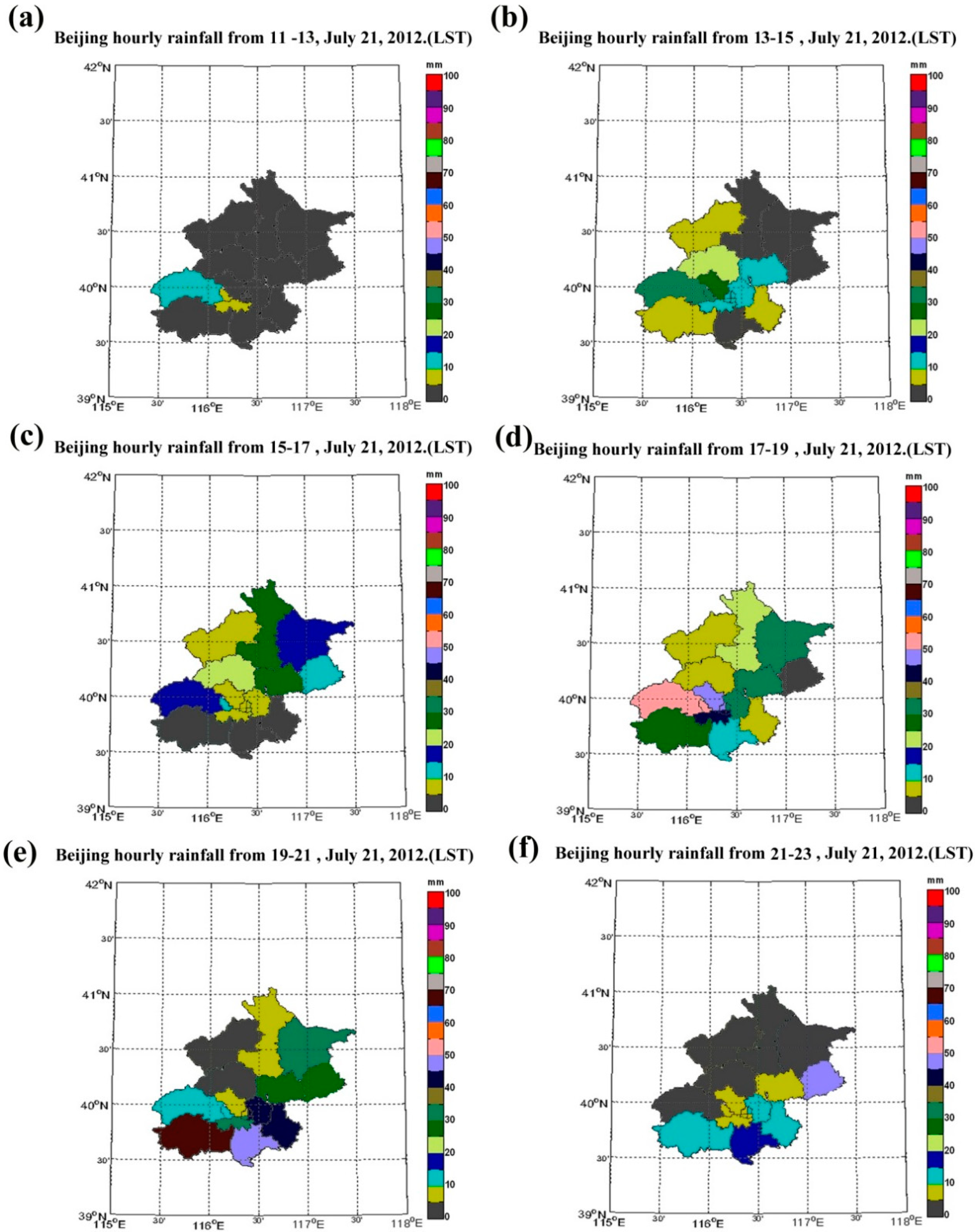
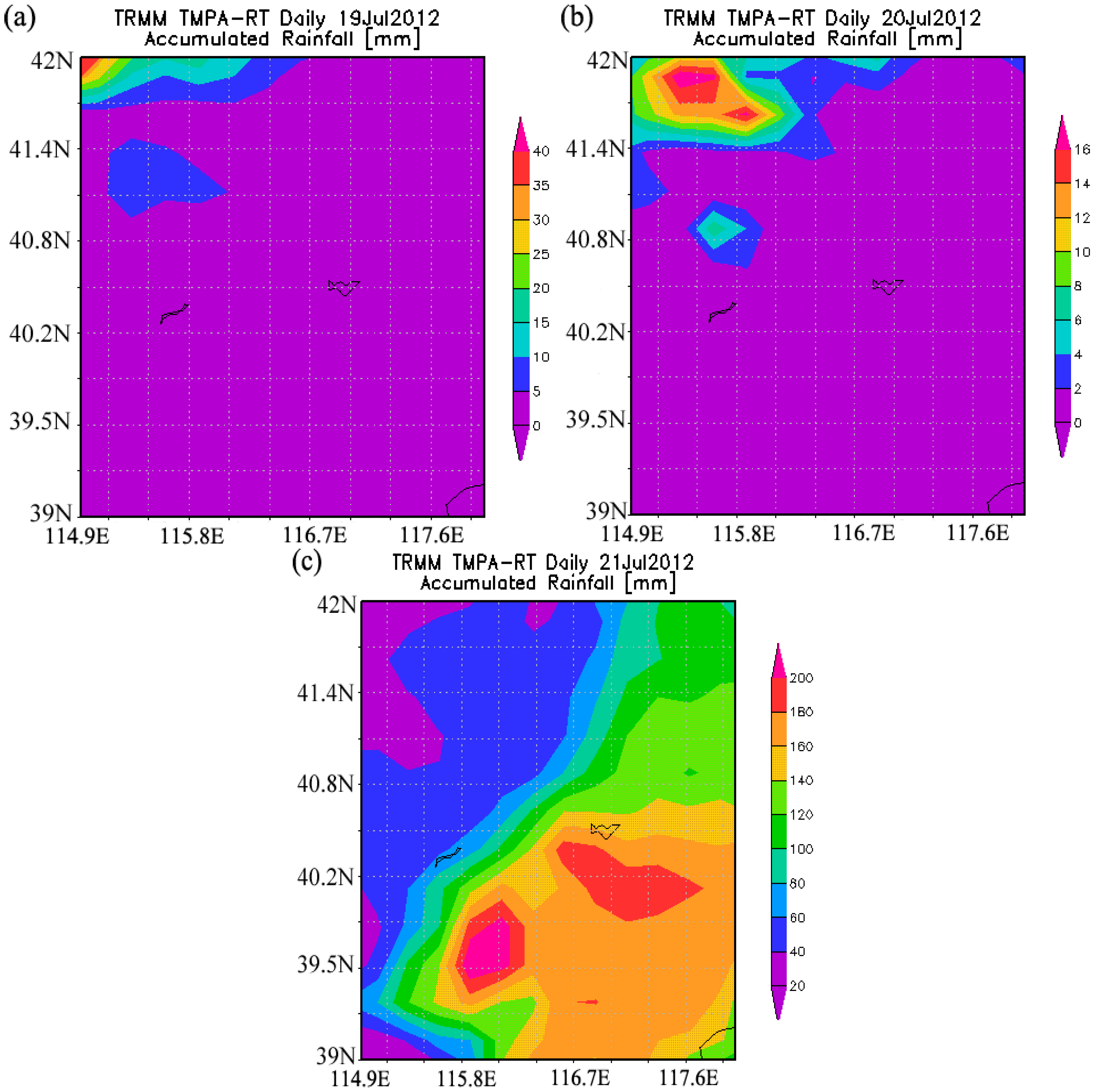
3.3. The Urban Heat Island Effect and Canyon Effect
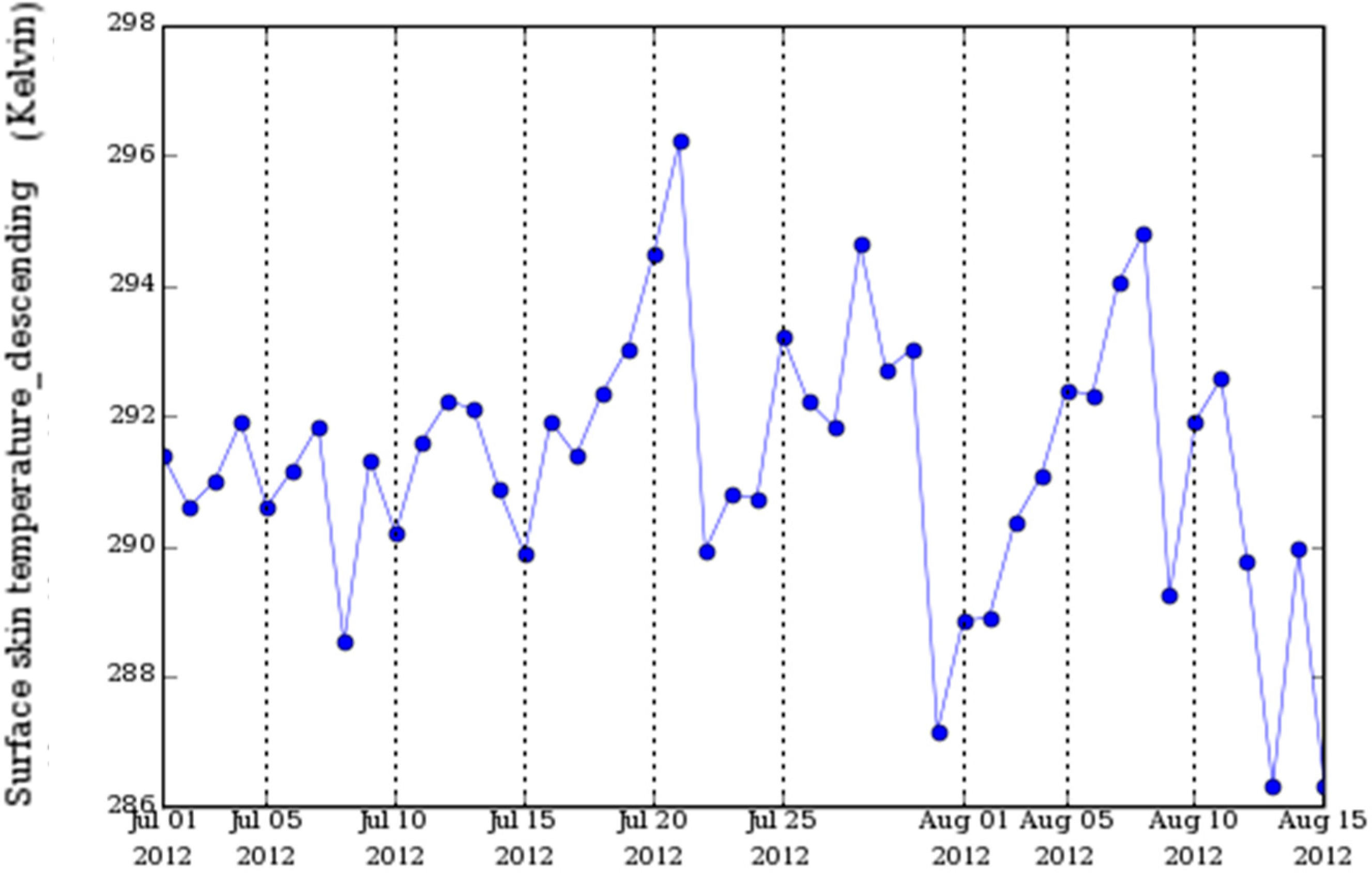
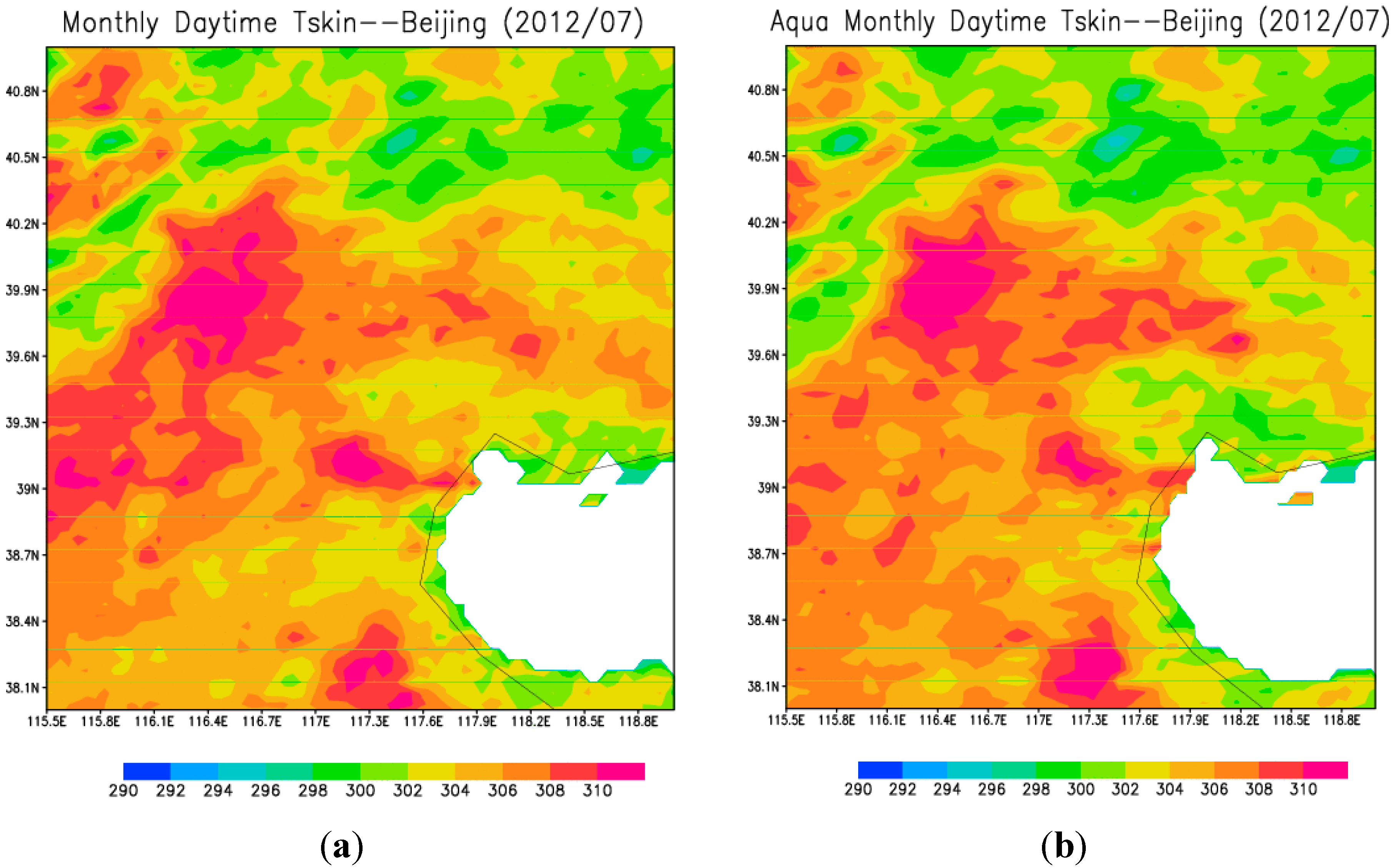

3.4. Aerosols and Clouds Properties
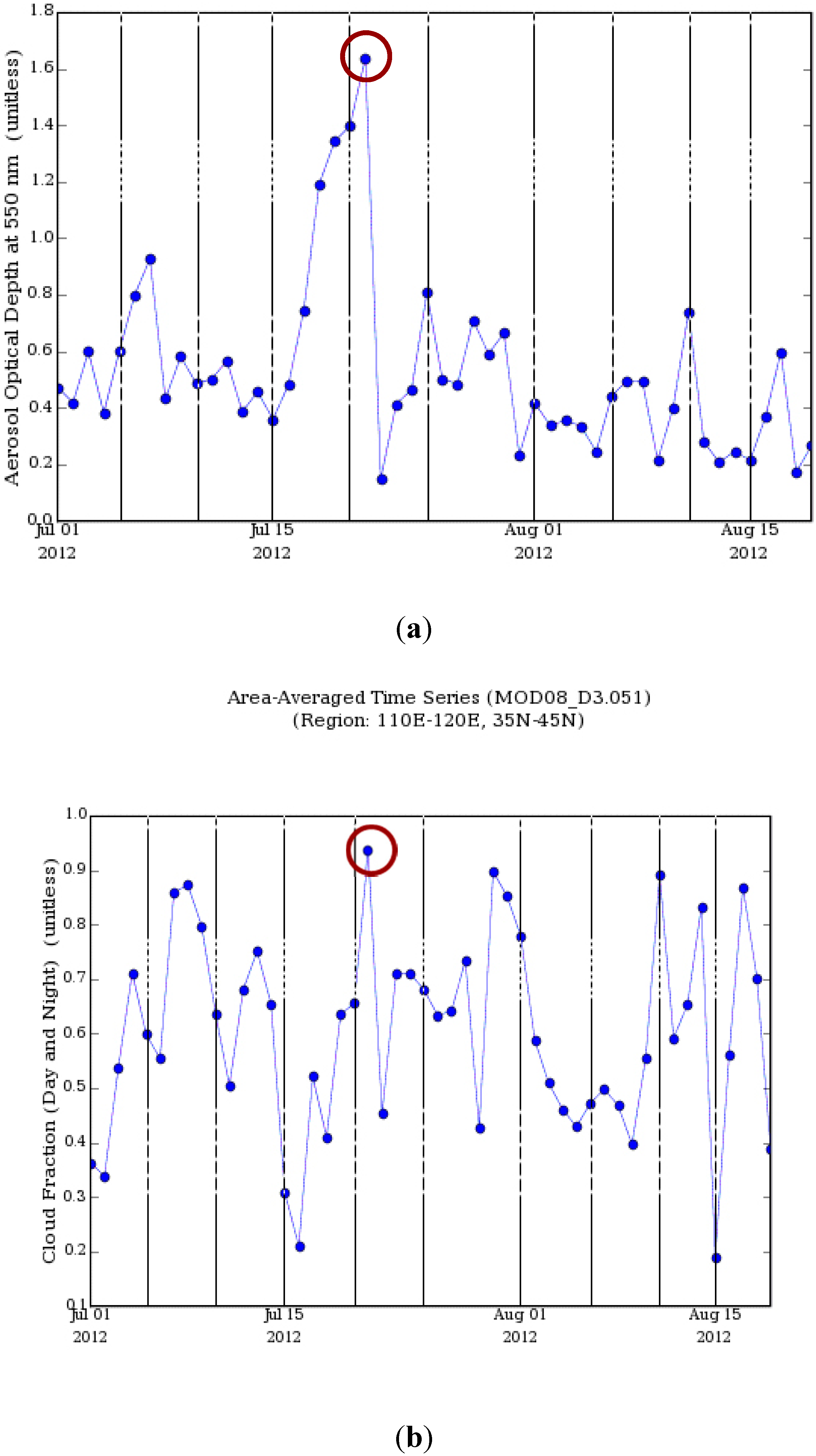


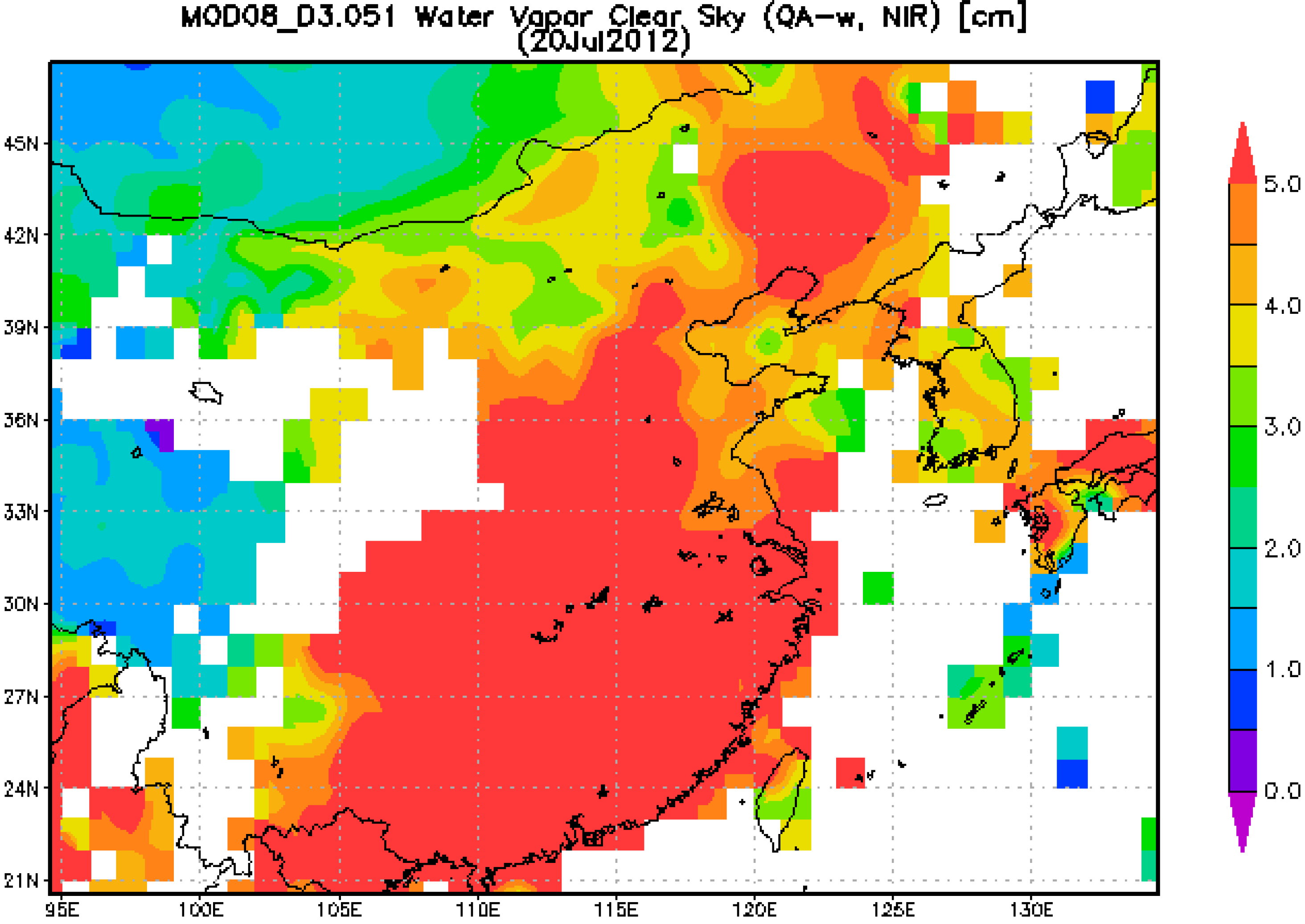
4. Final Discussions
Acknowledgements
Author Contributions
Conflicts of Interest
References
- IPCC. Climate Change 2007: The Physical Science Basis; Cambridge University Press: Cambridge, UK, 2007; p. 996. [Google Scholar]
- Yu, L.-F.; Liao, X.-N.; Li, T. Mesoscale analysis on torrential rain over Beijing area in July 1998. Meteorol. Mon. 1999, 25, 44–48. (In Chinese) [Google Scholar]
- Guo, Y. Analysis of apparent heat sources and moisture sinks over Beijing during the heavy rain in 1998. Meteorol. Mon. 2000, 26, 7–14. (In Chinese) [Google Scholar]
- Mao, D.-Y.; Qiao, L.; Chen, T.; Yang, K.-M. A mesoscale analysis of a heavy rainfall event on 10 July 2004 in Beijing. Meteorol. Mon. 2005, 31, 42–46. (In Chinese) [Google Scholar]
- Liao, X.-N.; Wei, D.; Shi, Z.-Y.; Xuan, C.-Y. Some characteristics of torrential rain events during continuous drought period in Beijing. Plateau Meteorol. 2011, 30, 749–759. (In Chinese) [Google Scholar]
- Sun, J.; Chen, Y.; Yang, S.-N.; Dai, K.; Chen, T.; Yao, R.; Xu, J. Analysis and thinking on the extremes of the 21 July 2012 torrential rain in Beijing Part 2: Preliminary causation analysis and thinking. Meteorol. Mon. 2012, 38, 1267–1277. (In Chinese) [Google Scholar]
- Sun, J.-S.; He, N.; Wang, G.-R.; Chen, M.-X.; Liao, X.-N.; Wang, H. Preliminary analysis on synoptic configuration evolvement and mechanism of a torrential rain occurring in Beijing on 21 July 2012. Torrential Rain Disasters 2012, 31, 218–225. (In Chinese) [Google Scholar]
- Niyogi, D.; Pyle, P.; Lei, M.; Pal Arya, S.; Kishtawal, C.M.; Shepherd, M.; Chen, F.; Wolfe, B. Urban modification of thunderstorms: An observational storm climatology and model case study for the Indianapolis urban region. J. Appl. Meteor. Climatol. 2011, 50, 1129–1144. [Google Scholar] [CrossRef]
- Shepherd, M.; Mote, T.; Dowd, J.; Roden, M.; Knox, P.; MoCutcheon, S.C.; Nelson, S.E. An overview of synoptic and mesoscale factors contributing to the disastrous Atlanta flood of 2009. Bull. Am. Meteorol. Soc. 2001, 92, 861–870. [Google Scholar] [CrossRef]
- Yun, C.; Sun, J.; Xu, J.; Yang, S.; Zong, Z.; Chen, T.; Fang, C.; Sheng, J. Analysis and thinking on the extremes of the 21 July 2012 torrential rain in Beijing Part 1: Observation and thinking. Meteorol. Mon. 2012, 38, 1255–1266. (In Chinese) [Google Scholar]
- Easterling, D.R.; Meehl, G.A.; Parmesan, C.; Changnon, S.A.; Karl, T.R.; Mearns, L.O. Climate extremes: Observations, modeling, and impacts. Science 2000, 289, 2068–2074. [Google Scholar] [CrossRef] [PubMed]
- Jin, M.; Dickinson, R.E. Land surface skin temperature climatology: Benefitting from the strengths of satellite observations. Environ. Res. Lett. 2010, 5, 044004. [Google Scholar] [CrossRef]
- Wan, Z.; Li, Z.-L. Radiance-based validation of the V5 MODIS land-surface temperature product. Int. J. Remote Sens. 2008, 29, 5373–5395. [Google Scholar] [CrossRef]
- Myneni, R.B.; Nemani, R.R.; Running, S.W. Estimation of global leaf area index and absorbed par using radiative transfer models. IEEE Trans. Geosci. Remote Sens. 1997, 35, 1380–1393. [Google Scholar] [CrossRef]
- Friedl, M.A.; Mclver, D.K.; Hodges, J.C.F.; Zhang, X.Y.; Muchoney, D.; Strahler, A.H.; Woodcock, C.E.; Gopal, S.; Schneider, A.; Cooper, A.; et al. Global land cover mapping from MODIS: Algorithms and early results. Remote Sens. Environ. 2002, 83, 287–302. [Google Scholar] [CrossRef]
- Gao, B.C.; Yang, P.; Han, W.; Li, R.R.; Wiscombe, W.J. An algorithm using visible and 1.38-m channels to retrieve cirrus cloud reflectances from aircraft and satellite data. IEEE Trans. Geosci. Remote Sens. 2002, 40, 1659–1668. [Google Scholar] [CrossRef]
- Schaaf, C.B.; Gao, F.; Strahler, A.H.; Lucht, W.; Li, X.W.; Tsang, T.; Strugnell, N.C.; Zhang, X.Y.; Jin, Y.F.; Muller, J.P.; et al. First operational BRDF, albedo nadir reflectance products from MODIS. Remote Sens. Environ. 2002, 83, 135–148. [Google Scholar] [CrossRef]
- Hall, D.H.; Riggs, G.A.; Salomonson, V.V.; DiGirolamo, N.E.; Bayr, K.J. MODIS snow-cover products. Remote Sens. Environ. 2002, 83, 181–194. [Google Scholar] [CrossRef]
- King, M.D.; Menzel, W.P.; Kaufman, Y.J.; Tanré, D.; Gao, B.C.; Platnick, S.; Ackerman, S.A.; Remer, L.A.; Pincus, R.; Hubanks, P.A. Cloud and aerosol properties, precipitable water, and profiles of temperature and humidity from MODIS. IEEE Trans. Geosci. Remote Sens. 2003, 41, 442–458. [Google Scholar] [CrossRef]
- Huffman, G.; Coauthors, J. The TRMM multisatellite precipitation analysis (TMPA): Quasi global, multiyear, combined-sensor precipitation estimates at fine scales. J. Hydrometeor. 2007, 8, 38–55. [Google Scholar] [CrossRef]
- Zhang, X.-D. Radar features and simulation analysis of a heavy rainfall event. Meteorol. Sci. Technol. 2010, 38, 550–559. (In Chinese) [Google Scholar]
- Jiang, X.; Li, Z.-J.; Gong, C.-N.; Li, X.; Fu, C.-L. A classification-based research on rainstorm processes around Beijing caused by mongolia-baikal low. Trans. Atmos. Sci. 2010, 33, 412–419. [Google Scholar]
- Twomey, S. The influence of pollution on the shortwave albedo of clouds. J. Atmos. Sci. 1997, 34, 1149–1152. [Google Scholar] [CrossRef]
- Jin, M.; Shepherd, J.M. Aerosol relationships to warm season clouds and rainfall at monthly scales over east China: Urban land versus ocean. J. Geophys. Res. 2005, 113. [Google Scholar] [CrossRef]
- Rosenfeld, D.; Lohmann, U.; Raga, G.B.; O’Dowd, C.D.; Kulmala, M.; Fuzzi, S.; Reissell, A.; Andreae, M.O. Flood or drought: How do aerosols affect precipitation? Science 2008, 321, 1309–1313. [Google Scholar] [CrossRef]
- Ackerman, S.; Toon, O.B.; Stevens, D.E.; Heymsfield, A.J.; Ramanathan, V.; Welton, E.J. Reduction of tropical cloudiness. Science 2000, 288, 1042–1047. [Google Scholar] [CrossRef] [PubMed]
- Nakajima, T.; King, M.D. Determination of the optical thickness and effective particle radius of clouds from reflected solar radiation measurements. Part I: Theory. J. Atmcbpheric Sci. 1990, 47, 1878–1893. [Google Scholar] [CrossRef]
- Jin, M.; Shepherd, J.M.; King, M.D. Urban aerosols and their interaction with clouds and rainfall: A case study for New York and Houston. J. Geophys. Res. 2005, 110. [Google Scholar] [CrossRef]
- Gong, P.; Liang, S.; Carlton, E.J.; Jiang, Q.; Wu, J.; Wang, L.; Remais, J.V.J. Urbanization and health in China. Lancet 2012, 379, 843–852. [Google Scholar] [CrossRef] [PubMed]
- Jin, M.; Dickinson, R.E.; Zhang, D.-L. The footprint of urban areas on global climate as characterized by MODIS. J. Clim. 2005, 18, 1551–1565. [Google Scholar] [CrossRef]
- Jin, M. Developing an index to measure urban heat island effect using satellite land skin temperature and land cover observations. J. Clim. 2012, 25, 6193–6201. [Google Scholar] [CrossRef]
© 2015 by the authors; licensee MDPI, Basel, Switzerland. This article is an open access article distributed under the terms and conditions of the Creative Commons Attribution license (http://creativecommons.org/licenses/by/4.0/).
Share and Cite
Jin, M.S.; Li, Y.; Su, D. Urban-Induced Mechanisms for an Extreme Rainfall Event in Beijing China: A Satellite Perspective. Climate 2015, 3, 193-209. https://doi.org/10.3390/cli3010193
Jin MS, Li Y, Su D. Urban-Induced Mechanisms for an Extreme Rainfall Event in Beijing China: A Satellite Perspective. Climate. 2015; 3(1):193-209. https://doi.org/10.3390/cli3010193
Chicago/Turabian StyleJin, Menglin S., Yu Li, and Debin Su. 2015. "Urban-Induced Mechanisms for an Extreme Rainfall Event in Beijing China: A Satellite Perspective" Climate 3, no. 1: 193-209. https://doi.org/10.3390/cli3010193
APA StyleJin, M. S., Li, Y., & Su, D. (2015). Urban-Induced Mechanisms for an Extreme Rainfall Event in Beijing China: A Satellite Perspective. Climate, 3(1), 193-209. https://doi.org/10.3390/cli3010193




